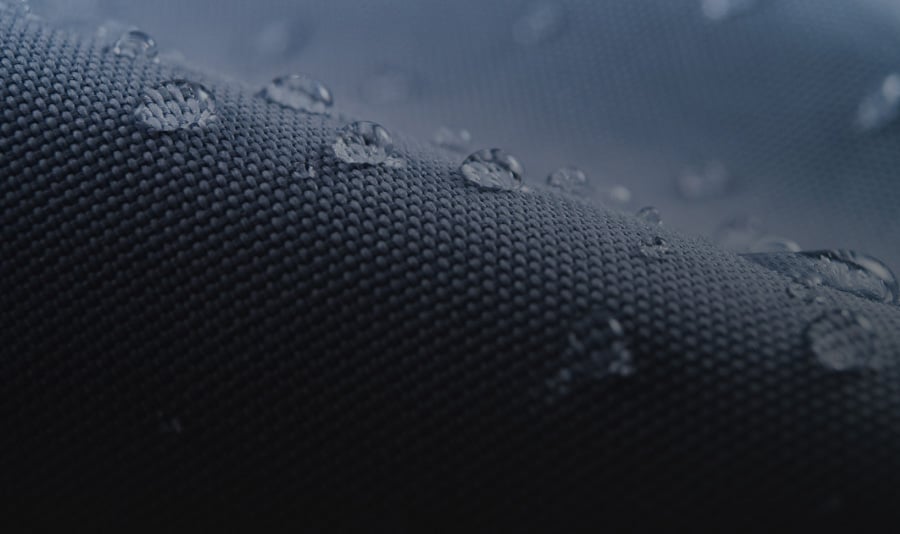
100% PFC-free
All our products are now entirely PFC-free.
Our commitment
Another important step towards sustainability and environmental friendliness! All our clothing items, packs, and bags have been completely PFC-free since the spring/summer 2019 collection. As of 2025, all our products are entirely PFAS-free.
Our challenge
Our motivation
Clothing is important to us – very important, as we wear it daily. It keeps us warm and protects us from environmental influences such as rain and snow.
Therefore, the production of our clothing is particularly essential to us because it means so much to us and our customers. We pay attention to the materials used in manufacturing and the conditions under which they are produced. As a manufacturer of outdoor clothing, we develop products for experiencing and exploring nature. Consequently, preserving nature and our living spaces is a priority for us, as we, too, love being outdoors and want to protect the world for future generations.
Our partners
We’re not alone on our journey toward a sustainable collection. From the early stages, we have partnered with organizations to help us achieve our goals. The bluesign label ensures environmentally friendly production, while the Fair Wear Foundation monitors the working conditions of employees in developing countries.
Would you like to know more about this topic? You’ll find our most important partners and their websites here.
This is what our experts say

Philippa Hill
Postgraduate researcher
School of Design, University of Leeds (UK)
FAQs
PFCs are primarily used due to the permanent water and dirt-repellent characteristics they provide to impregnations (DWR) on the outer material of weatherproof clothing. Aside from their water and dirt-repellent characteristics, these products are durable and resistant.
Yes, absolutely! Regulatory and supervisory boards all over the world have indicated that consumers who use outdoor products containing PFC are not subjected to higher levels of risk.
Currently, there are a number of alternatives to water-repellent coatings containing PFCs. They are based on different technologies. Tests must be done on every single material and the correct coatings chosen. When it comes to water-repellent quality and durability, our PFC-free coatings are in no way inferior to ones containing PFCs. The only thing that is not currently possible with PFC-free coatings is an oil-repellent effect.
Softshell jackets that are only water-repellent and not waterproof have a coating on their outer layer, allowing water to drip off. From the summer collection 2019 onwards, all our softshell jackets are PFC-free. Fleece jackets have no water-repellent coating and are therefore completely PFC-free.
Jack Wolfskin’s Texapore weatherproof technology is based on membranes and coatings made from polyurethane (PU). These membranes and coatings are extremely flexible and durable, and offer the very best wind and waterproofness as well as high breathability. No PFCs are used in Texapore products.
Jack Wolfskin has been dealing with the issue of PFCs and PFAS for a very long time. In the early 2010s, the public mainly talked about “PFC” when it came to the problematic properties of water-repellent finishes and coatings. For this reason, we also used this word in our communication.
PFAS are a larger group of chemicals that have many different compounds such as PFOA and PFOS.
We already meant PFAS back then and also said perfluorinated and polyfluorinated chemicals when we talked about PFCs. Many of our customers still have the term in mind, which is why we continue to use the term even if we are actually talking about PFAS.






 Germany
Germany Austria
Austria Switzerland
Switzerland United Kingdom
United Kingdom Belgium
Belgium Bulgaria
Bulgaria China
China Croatia
Croatia Cyprus
Cyprus Czech Republic
Czech Republic Denmark
Denmark España
España Estonia
Estonia Finland
Finland France
France Greece
Greece Hungary
Hungary Ireland
Ireland Italy
Italy Japan
Japan Latvia
Latvia Lithuania
Lithuania Luxembourg
Luxembourg Netherlands
Netherlands Polska
Polska Portugal
Portugal Romania
Romania Slovakia
Slovakia Slovenia
Slovenia Sweden
Sweden LaCordee.com - CAN
LaCordee.com - CAN